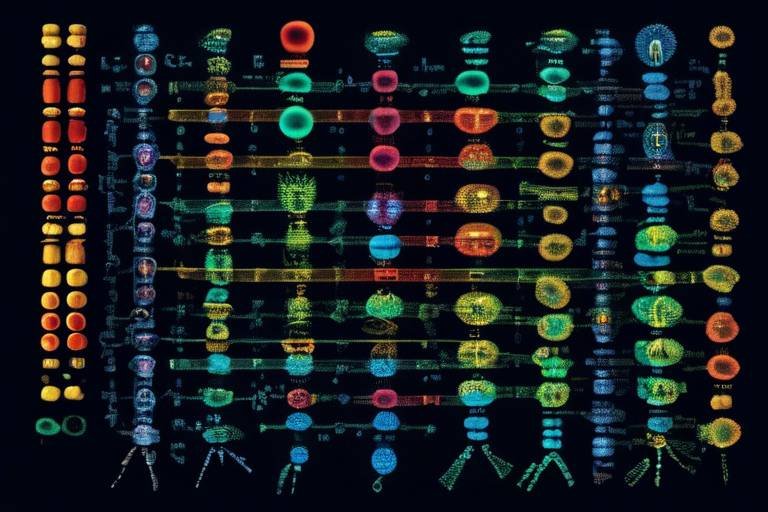Exploring the Role of Technology in Agricultural Biotechnology
In today's fast-paced world, the intersection of technology and agriculture is more critical than ever. As we face the challenges of feeding a growing global population, agricultural biotechnology emerges as a beacon of hope. It leverages cutting-edge technologies to enhance crop production, improve food quality, and ensure sustainability. But what does this really mean for farmers and consumers alike? Let's dive into how technology is reshaping the landscape of agricultural biotechnology, making food production not only more efficient but also more environmentally friendly.
At the heart of this transformation are innovative techniques that allow scientists to modify plants at a genetic level. Imagine being able to edit a plant's DNA as easily as you would edit a text document. Technologies like CRISPR (Clustered Regularly Interspaced Short Palindromic Repeats) have revolutionized the way we approach crop improvement. This powerful tool enables precise changes to the genetic makeup of crops, leading to enhanced traits such as drought resistance, pest tolerance, and improved nutritional content. With such advancements, the potential for creating crops that can thrive in adverse conditions is not just a dream; it's becoming a reality.
Moreover, these technological advancements are not just about increasing yields; they're about doing so sustainably. By integrating biotechnology with traditional farming practices, we can reduce our reliance on harmful pesticides and fertilizers. This is where biopesticides and biofertilizers come into play. These natural alternatives not only help protect crops from pests but also enrich the soil, promoting a healthier ecosystem. The result? A farming approach that respects the environment while still maximizing productivity.
As we explore this fascinating field, it's essential to consider the broader implications. How do these technologies affect food security? What role do they play in the global economy? And, importantly, how are they perceived by the public? These questions are vital as we navigate the complexities of agricultural biotechnology. The innovations we discuss today are not just scientific advancements; they are critical components of our future food systems, shaping the way we grow, consume, and think about food.
- What is agricultural biotechnology? Agricultural biotechnology refers to the use of scientific tools and techniques, including genetic engineering, to modify plants and improve their traits.
- How does biotechnology improve crop yield? By introducing traits such as pest resistance and faster growth rates, biotechnology can significantly enhance crop productivity.
- What are the environmental benefits of biopesticides? Biopesticides are derived from natural materials and reduce chemical residues in the environment, promoting biodiversity and healthier ecosystems.
- How do precision agriculture technologies work? Precision agriculture utilizes tools like GPS and IoT to monitor and manage field variability in crops, leading to better decision-making and resource use.
- What challenges does agricultural biotechnology face? Key challenges include regulatory hurdles and public perception, which can impact the adoption of biotechnological innovations.

Advancements in Genetic Engineering
In recent years, genetic engineering has emerged as a groundbreaking force in the field of agricultural biotechnology. Imagine having the ability to edit the very DNA of crops, enhancing their resilience and productivity in ways that were previously unimaginable. This is not just a dream; it’s a reality brought to life by technologies like CRISPR-Cas9, which allows scientists to make precise changes to an organism's genome with remarkable accuracy.
CRISPR, short for Clustered Regularly Interspaced Short Palindromic Repeats, is akin to a molecular scissors that can cut DNA at specific locations. This technology has opened up a world of possibilities for crop improvement, enabling the development of plants that can withstand harsh conditions such as drought, pests, and diseases. For instance, researchers have successfully modified rice and wheat varieties to enhance their resistance to certain pathogens, thereby reducing dependency on chemical pesticides.
But what does this mean for sustainability? The implications are enormous. By enhancing crop traits through genetic engineering, farmers can achieve higher yields without expanding agricultural land. This is particularly crucial as the global population continues to grow, and the demand for food increases. With the right genetic modifications, crops can not only produce more but also require fewer resources, such as water and fertilizers, thereby alleviating some of the environmental pressures associated with traditional farming practices.
To illustrate the impact of genetic engineering on agriculture, consider the following table:
| Crop Type | Genetic Modification | Benefit |
|---|---|---|
| Rice | CRISPR-enhanced pest resistance | Reduced pesticide use and increased yield |
| Wheat | Drought resistance genes | Improved survival rates in arid conditions |
| Tomatoes | Enhanced nutritional profile | Higher vitamin content for better health |
Moreover, the advancements in genetic engineering extend beyond just crop yield. They also hold the potential to improve the nutritional content of food. For example, scientists are working on biofortifying crops to combat malnutrition in developing countries. Imagine a world where staple foods like rice are enriched with essential vitamins and minerals, providing better nourishment to millions of people. This is not just a possibility; it's a goal that researchers are striving to achieve through innovative genetic modifications.
However, while the advancements in genetic engineering are promising, they do come with challenges. Public perception and regulatory frameworks can significantly influence the adoption of these technologies. It’s essential to address the concerns of consumers and ensure that the benefits of genetic engineering are communicated effectively. After all, the future of food production may depend on our ability to embrace these innovations while fostering trust and understanding within the community.
As we look ahead, it’s clear that advancements in genetic engineering are set to play a pivotal role in shaping the future of agriculture. With the right balance of innovation, sustainability, and public engagement, we can harness the power of technology to create a more resilient and productive food system for generations to come.
- What is genetic engineering in agriculture? Genetic engineering in agriculture refers to the manipulation of an organism's DNA to enhance desirable traits such as yield, disease resistance, and nutritional value.
- How does CRISPR work? CRISPR works by using a guide RNA to identify a specific DNA sequence, allowing the Cas9 enzyme to create a cut at that location, enabling the addition or alteration of genetic material.
- What are the benefits of genetically engineered crops? Genetically engineered crops can lead to increased yields, reduced pesticide use, improved nutritional content, and enhanced resilience to environmental stressors.
- Are genetically engineered crops safe to eat? Numerous studies have shown that genetically engineered crops are safe to eat and do not pose greater risks than conventional crops.

Impact of Biotechnology on Crop Yield
Biotechnology has emerged as a game-changer in the agricultural sector, significantly enhancing crop yield and ensuring food security for a growing global population. By harnessing the power of biological processes, farmers can now cultivate crops that are not only more resilient but also yield higher outputs. Imagine being able to plant a seed that has been genetically modified to withstand drought or resist pests—this is no longer just a dream; it’s a reality thanks to advancements in biotechnology.
One of the most notable impacts of biotechnology on crop yield is the development of genetically modified organisms (GMOs). These crops are engineered to exhibit specific traits that improve their growth and resistance to environmental stresses. For instance, crops like Bt cotton and Bt corn have been modified to produce a natural insecticide, dramatically reducing the need for chemical pesticides. This not only leads to higher yields but also contributes to a more sustainable farming practice. In fact, studies have shown that farmers who adopt GMO crops often see an increase in their harvest by as much as 20-30% compared to traditional varieties.
Moreover, biotechnology aids in enhancing the nutritional content of crops. Biofortification, a process that involves increasing the nutritional value of food crops, is a prime example. Crops such as Golden Rice, which is enriched with Vitamin A, are designed to combat malnutrition in regions where rice is a staple food. This not only boosts the yield but also improves the health of communities reliant on these crops.
Another significant aspect is the role of biotechnology in developing crops that can thrive in adverse conditions. With climate change posing a serious threat to agriculture, scientists are working on crops that can tolerate extreme weather conditions, such as droughts and floods. These innovations are crucial for maintaining crop yields in regions that are increasingly becoming uninhabitable for traditional farming practices. The table below illustrates some of the key traits of biotech crops that contribute to increased yields:
| Trait | Benefit | Example Crop |
|---|---|---|
| Pest Resistance | Reduces crop losses due to insect damage | Bt Corn |
| Drought Tolerance | Maintains yield during water scarcity | Drought-Tolerant Maize |
| Nutritional Enhancement | Improves health outcomes | Golden Rice |
| Herbicide Tolerance | Facilitates weed management and reduces competition | Roundup Ready Soybeans |
In addition to these benefits, biotechnology also plays a vital role in reducing agricultural waste. With better pest and disease management, farmers can minimize crop losses and ensure that more of their harvest reaches the market. This reduction in waste not only boosts the economic viability of farming but also contributes to a more sustainable food system.
However, it’s essential to recognize that the adoption of biotechnology is not without its challenges. While the benefits are substantial, some farmers face barriers such as access to technology, knowledge gaps, and economic constraints. Addressing these challenges is crucial for maximizing the potential of biotechnology in enhancing crop yield and ensuring food security worldwide.
- What are GMOs? GMOs, or genetically modified organisms, are organisms whose genetic material has been altered using genetic engineering techniques to exhibit desired traits.
- How does biotechnology improve crop yield? Biotechnology improves crop yield by creating plants that are resistant to pests, diseases, and environmental stresses, ultimately leading to higher productivity.
- Are biotech crops safe for consumption? Yes, numerous studies and regulatory assessments have shown that biotech crops are safe for human consumption and the environment.
- What is biofortification? Biofortification is the process of increasing the nutritional value of food crops through biotechnology to combat malnutrition.

Biopesticides and Biofertilizers
In the quest for sustainable agriculture, biopesticides and biofertilizers have emerged as game-changers. These innovative solutions offer a more environmentally friendly approach to pest management and soil health, making them increasingly popular among modern farmers. But what exactly are they, and how do they work? Let's dive deeper into these fascinating components of agricultural biotechnology.
Biopesticides are derived from natural materials such as plants, bacteria, and minerals. Unlike traditional chemical pesticides, which can leave harmful residues in the environment, biopesticides target specific pests while being safe for non-target organisms, including beneficial insects and humans. This specificity not only reduces the risk of chemical exposure but also promotes biodiversity in agricultural ecosystems. For instance, a common biopesticide, Bacillus thuringiensis (Bt), is a bacterium that produces toxins harmful to certain insect larvae, effectively protecting crops without harming other wildlife.
On the other hand, biofertilizers are natural fertilizers that enhance soil fertility through the promotion of beneficial microorganisms. These microorganisms can fix nitrogen, solubilize phosphorus, and decompose organic matter, thereby improving soil structure and nutrient availability. The use of biofertilizers not only boosts plant growth but also reduces the reliance on synthetic fertilizers, which can lead to soil degradation and water pollution. Farmers using biofertilizers often report healthier plants and better yields, showcasing the potential of these natural solutions.
To illustrate the effectiveness of biopesticides and biofertilizers, consider the following table that compares their benefits with traditional chemical alternatives:
| Aspect | Biopesticides & Biofertilizers | Chemical Pesticides & Fertilizers |
|---|---|---|
| Environmental Impact | Low toxicity, promotes biodiversity | High toxicity, potential for pollution |
| Target Specificity | Specific to pests/beneficial for non-targets | Broad-spectrum, can harm beneficial species |
| Soil Health | Enhances soil fertility and structure | Can degrade soil health over time |
| Cost | Generally lower long-term costs | Higher ongoing costs due to repeated applications |
As the demand for sustainable farming practices grows, the adoption of biopesticides and biofertilizers is on the rise. Farmers are increasingly recognizing the long-term benefits of these products, not just for their crops, but for the environment as well. However, the transition to these alternatives is not without its challenges. Education and awareness about the effectiveness and application of biopesticides and biofertilizers are crucial for their widespread acceptance.
In conclusion, biopesticides and biofertilizers represent a significant leap toward sustainable agriculture. By leveraging the power of nature, farmers can manage pests and enhance soil health in a way that benefits both their yields and the environment. As we move forward, it is essential to continue supporting research and development in this field to unlock even more potential for these natural solutions.
- What are biopesticides? Biopesticides are natural substances used to control pests and diseases in crops, offering a safer alternative to chemical pesticides.
- How do biofertilizers work? Biofertilizers enhance soil fertility by introducing beneficial microorganisms that improve nutrient availability and soil structure.
- Are biopesticides effective? Yes, biopesticides have been shown to be effective against specific pests while being safe for non-target organisms.
- Can I use biopesticides and biofertilizers together? Absolutely! Using both together can lead to improved crop health and yield.

Benefits of Biopesticides
Biopesticides are rapidly gaining traction in the agricultural sector, and for good reason. These environmentally friendly alternatives to traditional chemical pesticides offer a myriad of benefits that not only enhance crop protection but also promote sustainability. One of the most compelling advantages of biopesticides is their ability to reduce chemical residues on food products. With increasing consumer awareness about food safety, farmers are under pressure to minimize the use of synthetic chemicals. By integrating biopesticides into their farming practices, they can produce cleaner, safer food, which is a win-win for both producers and consumers.
Another significant benefit of biopesticides is their role in increasing biodiversity. Unlike conventional pesticides that often harm non-target species, biopesticides are typically more selective in their action. This means they can effectively target pests without disrupting the ecosystem. For instance, using biopesticides derived from natural sources like plants or microorganisms can help preserve beneficial insects, which are crucial for pollination and controlling pest populations naturally. As a result, farmers can maintain a healthier ecosystem while still achieving effective pest management.
Moreover, biopesticides can help in managing pest resistance. With the continuous use of chemical pesticides, many pests develop resistance, leading to a cycle of increased chemical applications and diminishing effectiveness. Biopesticides, on the other hand, often work through different modes of action, making it difficult for pests to adapt. This diversity in pest control methods not only prolongs the effectiveness of pest management strategies but also contributes to sustainable agricultural practices.
It's also worth noting that biopesticides can be cost-effective in the long run. While the initial investment might be comparable to chemical pesticides, the reduced need for additional applications and the lower risk of crop damage can lead to significant savings. Farmers can allocate their resources more efficiently, ensuring a better return on investment. Additionally, with the growing demand for organic and sustainably produced foods, adopting biopesticides can enhance market competitiveness.
In summary, the benefits of biopesticides extend far beyond mere pest control. They foster a more sustainable farming environment, promote biodiversity, help manage pest resistance, and offer economic advantages. As the agricultural landscape continues to evolve, embracing biopesticides could be a key factor in achieving a more sustainable and productive future.
- What are biopesticides? Biopesticides are natural substances used for controlling pests and diseases in agriculture, derived from plants, animals, or microorganisms.
- How do biopesticides differ from chemical pesticides? Unlike chemical pesticides, biopesticides are typically less toxic, more selective in their action, and often have minimal impact on non-target organisms and the environment.
- Are biopesticides effective? Yes, biopesticides can be highly effective when used correctly, often providing comparable results to traditional pesticides while promoting sustainability.
- Can biopesticides be used in organic farming? Absolutely! Biopesticides are a crucial component of organic farming practices and are approved for use in organic agriculture.

Role of Biofertilizers in Soil Health
Biofertilizers are a game-changer in the realm of sustainable agriculture, playing a crucial role in enhancing soil health and fertility. Unlike synthetic fertilizers that can deplete soil nutrients over time and lead to environmental degradation, biofertilizers harness the power of natural processes to promote plant growth. They are composed of living microorganisms that, when applied to seeds, soil, or plants, enhance the availability of nutrients to the host plant.
One of the primary ways biofertilizers work is by fixing atmospheric nitrogen, a vital nutrient for plant growth. For instance, certain species of Rhizobium bacteria form symbiotic relationships with leguminous plants, converting nitrogen from the air into a form that plants can absorb. This not only reduces the need for chemical fertilizers but also improves soil structure and health. Additionally, biofertilizers can mobilize phosphorus and potassium—two other essential nutrients—making them more accessible to plants.
Moreover, biofertilizers contribute to the overall biodiversity of the soil microbiome. A healthy soil ecosystem is teeming with various microorganisms that work in harmony. When biofertilizers are introduced, they can outcompete harmful pathogens, thereby reducing disease incidence in crops. This biological control mechanism is a natural alternative to chemical pesticides, promoting a healthier growing environment.
Furthermore, the use of biofertilizers leads to improved soil structure and enhanced water retention capabilities. Healthy soils rich in organic matter can hold more moisture, which is particularly beneficial in regions prone to drought. This characteristic not only supports plant growth but also helps in maintaining the ecological balance.
To illustrate the benefits of biofertilizers, consider the following table that compares traditional fertilizers with biofertilizers:
| Aspect | Traditional Fertilizers | Biofertilizers |
|---|---|---|
| Nutrient Source | Synthetic | Natural Microorganisms |
| Soil Health Impact | Depletes nutrients | Enhances fertility |
| Environmental Impact | Pollution risk | Eco-friendly |
| Cost | Higher long-term costs | Lower long-term costs |
In conclusion, the role of biofertilizers in promoting soil health cannot be overstated. They not only provide essential nutrients to crops but also enhance the overall ecosystem of the soil. By adopting biofertilizers, farmers can achieve sustainable agricultural practices that benefit both their crops and the environment. As we move towards a future where sustainability is paramount, biofertilizers will undoubtedly play a critical role in shaping agricultural practices.
- What are biofertilizers? Biofertilizers are natural fertilizers that contain living microorganisms, which help in enhancing soil fertility and plant growth.
- How do biofertilizers improve soil health? They improve soil health by fixing nitrogen, mobilizing nutrients, and enhancing microbial diversity, which helps suppress plant diseases.
- Are biofertilizers environmentally friendly? Yes, biofertilizers are eco-friendly alternatives to chemical fertilizers, reducing pollution and promoting sustainable farming practices.
- Can biofertilizers replace chemical fertilizers? While they can significantly reduce the need for chemical fertilizers, a combination of both may be necessary depending on the specific agricultural context.

Precision Agriculture Technologies
In today's fast-paced world, the integration of technology into agriculture has become more than just a trend; it’s a necessity. Precision agriculture is a game-changer, allowing farmers to make data-driven decisions that can significantly enhance crop production while minimizing waste. Imagine a farmer equipped with tools that provide real-time data on soil health, moisture levels, and crop conditions—this is not science fiction; it’s the reality of modern farming.
At the heart of precision agriculture are technologies like GPS (Global Positioning System) and the Internet of Things (IoT). These tools enable farmers to monitor their fields with unprecedented accuracy. For instance, GPS technology allows for precise field mapping, which can help in planning planting patterns and optimizing irrigation. Meanwhile, IoT devices can collect data from various sensors placed throughout the farm, providing insights into everything from temperature fluctuations to pest movements.
But how do these technologies translate into tangible benefits for farmers? Let’s break it down:
- Enhanced Efficiency: By using GPS-guided tractors, farmers can reduce overlaps in field coverage, which minimizes fuel consumption and maximizes productivity.
- Data-Driven Decisions: With IoT sensors providing real-time data, farmers can make informed decisions about when to irrigate, fertilize, or apply pesticides, ensuring that resources are used judiciously.
- Cost Savings: By optimizing inputs such as water and fertilizers, farmers can significantly lower their operational costs while maintaining or increasing crop yields.
Moreover, precision agriculture is not just about technology; it’s about sustainability. By utilizing these advanced tools, farmers can lessen their environmental impact. For example, targeted applications of fertilizers and pesticides reduce runoff into nearby waterways, promoting a healthier ecosystem. This approach not only benefits the environment but also enhances the overall health of the crops, leading to higher quality produce.
As we look to the future, the potential of precision agriculture technologies is vast. With ongoing advancements in machine learning and artificial intelligence, we can expect even more sophisticated tools that can predict crop yields and identify potential issues before they become problems. The integration of drones for aerial surveillance is another exciting development, providing farmers with aerial imagery that can help assess crop health and identify areas needing attention.
In summary, precision agriculture technologies are revolutionizing the farming landscape. They empower farmers with the tools needed to enhance productivity, ensure sustainability, and ultimately secure food resources for a growing global population. As these technologies continue to evolve, they will undoubtedly play a pivotal role in shaping the future of agriculture.
1. What is precision agriculture?
Precision agriculture is a farming management concept that uses technology to monitor and manage field variability in crops. It leverages data and tools like GPS and IoT to optimize farming practices.
2. How does GPS technology benefit farmers?
GPS technology allows farmers to map their fields accurately, leading to better planning of planting, irrigation, and resource allocation, ultimately enhancing efficiency and reducing waste.
3. What role do IoT devices play in agriculture?
IoT devices collect real-time data from sensors placed throughout the farm, providing farmers with insights that help them make informed decisions about crop management and resource use.
4. Can precision agriculture help with sustainability?
Yes, precision agriculture promotes sustainability by optimizing the use of resources such as water and fertilizers, reducing environmental impact, and enhancing crop health.
5. What is the future of precision agriculture?
The future of precision agriculture is promising, with advancements in machine learning, artificial intelligence, and drone technology expected to further improve efficiency, productivity, and sustainability in farming.

Challenges in Agricultural Biotechnology
Despite the revolutionary potential of agricultural biotechnology, it is not without its challenges. These obstacles can significantly hinder the adoption and implementation of innovative technologies that could otherwise transform farming practices. One of the most pressing issues is the complex regulatory landscape that governs the use of biotechnological products. Regulations vary widely across different countries and regions, often creating confusion and uncertainty for farmers and biotech companies alike. For instance, in the European Union, stringent regulations make it difficult for genetically modified organisms (GMOs) to enter the market, while in the United States, the approval process is relatively more streamlined. This disparity can lead to a lack of uniformity in global agricultural practices.
Another critical challenge lies in public perception. Many consumers remain skeptical about biotechnology, often due to misconceptions or a lack of understanding of the science behind it. This skepticism can stem from various factors, including media portrayal, historical controversies, and personal beliefs about food safety and environmental sustainability. As a result, the acceptance of biotech products can be slow, affecting market dynamics and ultimately influencing farmers' decisions to adopt these technologies.
Moreover, the economic factors play a significant role in the adoption of agricultural biotechnology. Farmers may be hesitant to invest in new technologies due to high upfront costs, particularly if they are unsure about the return on investment. Additionally, smallholder farmers in developing countries often lack access to the necessary resources and infrastructure to implement advanced biotechnological solutions, which can widen the gap between large-scale agricultural operations and smaller farms.
To further illustrate these challenges, consider the following table that summarizes key obstacles in agricultural biotechnology:
| Challenge | Description |
|---|---|
| Regulatory Hurdles | Complex and varying regulations across regions hinder the approval of biotech products. |
| Public Perception | Skepticism and misconceptions about biotechnology affect consumer acceptance. |
| Economic Barriers | High costs and lack of resources can prevent farmers from adopting new technologies. |
| Access to Information | Limited knowledge and training on biotechnology can hinder effective implementation. |
Additionally, access to information is another significant hurdle. Farmers may not have the necessary education or training to understand and effectively utilize biotechnological advancements. This gap in knowledge can lead to underutilization of potentially beneficial technologies, further perpetuating inefficiencies in agricultural practices.
In conclusion, while the potential benefits of agricultural biotechnology are immense, addressing these challenges is crucial for its successful integration into modern farming. By improving regulatory frameworks, enhancing public understanding, and providing support to farmers, we can pave the way for a more sustainable and productive agricultural future.
- What are the main challenges faced by agricultural biotechnology? The main challenges include regulatory hurdles, public perception, economic barriers, and access to information.
- How do regulations affect biotechnology adoption? Regulations can create confusion and uncertainty, varying significantly between regions, which can slow down the approval process for biotechnological products.
- Why is public perception important in biotechnology? Public perception influences consumer acceptance, which in turn affects market dynamics and farmers' willingness to adopt new technologies.
- What can be done to improve the adoption of agricultural biotechnology? Enhancing regulatory frameworks, improving public understanding, and providing support to farmers can help increase adoption rates.

Regulatory Frameworks
Understanding the surrounding agricultural biotechnology is crucial for its advancement and acceptance in modern farming. These frameworks are designed to ensure that biotechnological innovations, such as genetically modified organisms (GMOs), are safe for human consumption and the environment. However, the landscape is complex and varies significantly from one country to another, leading to a patchwork of regulations that can be challenging for farmers and companies alike.
In many countries, regulatory bodies like the U.S. Department of Agriculture (USDA), Environmental Protection Agency (EPA), and Food and Drug Administration (FDA) play pivotal roles in assessing the safety and efficacy of biotechnological products. They evaluate everything from the potential environmental impact of a new crop to its nutritional profile. For instance, before a genetically modified crop can be introduced to the market, it must undergo rigorous testing to ensure that it does not pose any risks to human health or biodiversity.
Moreover, the process often involves a series of steps, which can include:
- Pre-market assessments: Comprehensive evaluations of the potential risks associated with the new technology.
- Public consultations: Engaging with various stakeholders, including farmers, consumers, and environmental groups, to gather feedback and address concerns.
- Post-market monitoring: Ongoing assessments to track the long-term effects of the biotechnology on health and the environment.
Despite these measures, regulatory frameworks are often criticized for being either too stringent or too lenient. In some regions, the lengthy approval processes can stifle innovation, making it difficult for new biotechnological advancements to reach the market in a timely manner. Conversely, in other areas, the lack of stringent regulations can lead to public distrust and fears about the safety of biotechnological products.
Additionally, the influence of international trade agreements cannot be overlooked. Countries that export agricultural products must align their regulations with those of their trading partners to avoid trade barriers. This alignment can lead to tensions, especially when differing standards exist regarding the safety and labeling of GMOs.
Overall, navigating the regulatory landscape is a critical aspect of agricultural biotechnology that impacts not only the development and implementation of new technologies but also the broader acceptance of biotechnology in agriculture. As we move forward, it is essential for stakeholders to advocate for clear, science-based regulations that foster innovation while ensuring safety and public trust.
- What is agricultural biotechnology? Agricultural biotechnology refers to the use of scientific tools and techniques, including genetic engineering, to improve plants, animals, and microorganisms for agricultural purposes.
- Why are regulatory frameworks important? Regulatory frameworks ensure the safety and efficacy of biotechnological products, protecting both consumers and the environment.
- How do regulations vary by country? Different countries have their own regulatory bodies and processes, leading to varying levels of scrutiny and approval timelines for biotechnological innovations.
- What role do public perceptions play in biotechnology? Public perceptions can significantly influence the acceptance and market dynamics of biotechnological products, often swaying regulatory approaches and consumer choices.

Public Perception and Acceptance
The acceptance of agricultural biotechnology is a complex tapestry woven from various threads of public opinion, cultural beliefs, and scientific understanding. It's fascinating how something as technical as biotechnology can stir such a wide array of emotions and opinions among the general populace. You might wonder, why is it that some people embrace these innovations while others are skeptical? The answer lies in a multitude of factors that shape public perception.
Firstly, education plays a pivotal role. Many individuals lack a clear understanding of what biotechnology entails and how it affects their food. This gap in knowledge can lead to fear and mistrust. For instance, when people hear terms like "genetically modified organisms" (GMOs), they often associate them with unnatural processes, raising concerns about health and safety. To bridge this knowledge gap, educational initiatives are essential. By providing transparent information about the benefits and safety of biotechnological advancements, we can foster a more informed public.
Moreover, cultural beliefs and values significantly influence how biotechnology is perceived. In some cultures, traditional farming practices are deeply rooted, and any deviation from these methods can be met with resistance. For example, in regions where organic farming is celebrated, the introduction of genetically modified crops may be viewed as a threat to their agricultural identity. This cultural clash can create a divide, making it crucial for stakeholders to engage with communities in a respectful and understanding manner.
Another critical aspect to consider is the role of media in shaping public opinion. News coverage can either bolster or undermine the acceptance of biotechnology. Sensational headlines often focus on potential risks while downplaying the benefits. This can lead to a skewed perception, where the public becomes more aware of the negatives than the positives. Therefore, responsible journalism that highlights both sides of the story is vital for fostering a balanced understanding of agricultural biotechnology.
To illustrate the diversity of public opinion, let’s take a look at a table that summarizes various factors influencing public perception:
| Factor | Influence on Perception |
|---|---|
| Education | Higher education levels often correlate with greater acceptance of biotechnology. |
| Cultural Beliefs | Traditional practices can lead to resistance against biotechnological innovations. |
| Media Representation | Negative media portrayals can shape public fear and skepticism. |
| Personal Experience | Individuals with positive experiences related to biotechnology are more likely to support it. |
As we navigate the complexities of public perception, it’s essential to recognize the importance of dialogue. Engaging with consumers, listening to their concerns, and addressing misconceptions can pave the way for greater acceptance. Initiatives that promote community involvement in agricultural practices can also help demystify biotechnology. When people feel included in the conversation, they are more likely to embrace change.
In conclusion, public perception and acceptance of agricultural biotechnology are influenced by a myriad of factors, including education, cultural beliefs, media representation, and personal experiences. By fostering open communication, providing education, and respecting cultural values, we can work towards a future where biotechnology is understood and accepted as a vital tool for sustainable agriculture.
- What is agricultural biotechnology? Agricultural biotechnology refers to the use of scientific tools and techniques, including genetic engineering, to modify plants and animals for improved traits.
- Why are people concerned about GMOs? Concerns often stem from fears about health risks, environmental impact, and ethical considerations related to altering natural organisms.
- How can education improve public perception? Education can demystify biotechnology, providing clear information about its benefits and safety, which can help alleviate fears and misconceptions.
- What role does media play in shaping public opinion? Media coverage can significantly influence public perception; responsible reporting that presents balanced viewpoints is essential.
Frequently Asked Questions
- What is agricultural biotechnology?
Agricultural biotechnology refers to a range of tools and techniques used to modify plants and animals to improve their productivity and sustainability. This includes genetic engineering, molecular markers, and tissue culture, all aimed at enhancing crop yields, pest resistance, and overall agricultural efficiency.
- How does genetic engineering benefit agriculture?
Genetic engineering allows for precise modifications to crops, enabling farmers to develop varieties that are more resistant to pests, diseases, and environmental stresses. Techniques like CRISPR make it possible to edit genes with high accuracy, leading to improved crop traits and sustainability in food production.
- What are biopesticides and how do they work?
Biopesticides are natural substances derived from plants, bacteria, or minerals that help control pests. They offer an environmentally friendly alternative to chemical pesticides, reducing chemical residues on food and promoting biodiversity by targeting specific pests without harming beneficial organisms.
- Can biofertilizers improve soil health?
Yes! Biofertilizers enhance soil fertility by introducing beneficial microorganisms that promote nutrient uptake in plants. They help maintain soil health and reduce reliance on synthetic fertilizers, contributing to a more sustainable agricultural practice.
- What is precision agriculture?
Precision agriculture is a farming management concept that uses technology to monitor and optimize field-level management. This includes tools like GPS and IoT devices that help farmers make informed decisions based on real-time data, improving efficiency and productivity in farming operations.
- What challenges does agricultural biotechnology face?
Despite its potential, agricultural biotechnology encounters several challenges, including regulatory hurdles that can delay the approval of new products, as well as public perception issues where consumers may have concerns about the safety and ethics of genetically modified organisms (GMOs).
- How do regulations impact agricultural biotechnology?
Regulatory frameworks are essential for ensuring the safety and efficacy of biotechnological products. They govern the approval process and usage of GMOs, influencing how quickly new technologies can be adopted in agriculture. Understanding these regulations is crucial for stakeholders in the industry.
- Why is public perception important in agricultural biotechnology?
Public perception significantly influences the acceptance and market dynamics of agricultural biotechnology. Factors such as consumer education, media portrayal, and cultural attitudes can affect how people view GMOs and biotechnological advancements, ultimately impacting their adoption by farmers and producers.



















